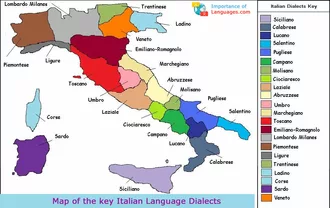Within any language or language group there may be significant changes in speech, vocabulary, and pronunciation. The term used to describe these changes is called a dialect. Some words or phrases that exist in one dialect may exist or be absent from different dialect.
The following are most commonly used dialects in the Italian language.
- Siciliano Italian Dialects
- Calabrese Italian Dialects
- Lucano Italian Dialects
- Salentino Italian Dialects
- Pugliese Italian Dialects
- Campano Italian Dialects
- Molisano Italian Dialects
- Ciociaresco Italian Dialects
- Laziale Italian Dialects
- Abruzzese Italian Dialects
- Umbro Italian Dialects
- Marchegiano Italian Dialects
- Toscano Italian Dialects
- Emilano-Romagnolo Italian Dialects
- Lombardo Milarnes Italian Dialects
- Piemontese Italian Dialects
- Ligure Italian Dialects
- Trentinese Italian Dialects
- Ladino Italian Dialects
- Corse Italian Dialects
- Veneto Italian Dialects
Different variants of the Italian language are spoken in many different nations and regions around the world, most commonly throughout Europe and Italy. However, the differences in regional dialects may not make one Italian speaker nearly incomprehensible to another. In most cases, the different dialects don’t have a specific written form of the language, but there’s usually a certain amount of literature that accompanies each dialect.
Interested in further study into Italian or confused on where to start? I recommend reading our Italian Beginners Guide

